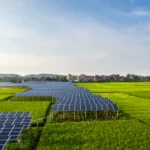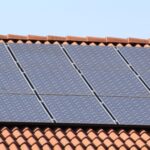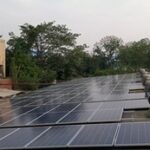Solar Net Metering in Industrial Units: Opportunities and Risks
Solar Net Metering in Industrial Units: Opportunities and Risks
Discoms in almost all the states provide the Net Metering facility by which the consumers can store the excess energy generated from the roof top solar plant with the Discom Grid and can use it in later hours.
During the Sun hours, when the load (in KW) of the factory or the commercial building is less than the roof top solar generation for any 15-minute block interval, the excess solar energy goes back to the Grid. During evening hours when the load is more and there is hardly any solar generation, then the stored solar energy is used back by the consumer from the Grid.
The accounting of the roof top solar energy is done on a monthly basis.
- At the end of each month, the solar energy is set off against the energy consumed by the factory or the Plant through a bi-directional meter installed by the Discom at the Consumer premises.
- If there is any excess solar energy which is not used during the month, it is taken forward to the next month in which the consumer can use the same.
- However, if there is unused solar energy left in March (end of Financial Year), then it will lapse as per the policy in Haryana while it will be paid at Rs 2.0 /kWh in Uttar Pradesh. Similar policies exist in other states also including Delhi, Rajasthan and Punjab.
The table below shows the energy accounting and settlement for 1 month (April) under Net Metering for a 100 KW solar system in a typical factory set up with a contract demand of 100 KW.
| Day | Energy Consumed(kWh) | Solar Generation)(kWh) | Banked Energy |
| 1 | 614 | 479 | – |
| 2 | 15 | 478 | 463 |
| 3 | 478 | 491 | 13 |
| 4 | 645 | 444 | – |
| 5 | 633 | 450 | – |
| 6 | 701 | 441 | – |
| 7 | 612 | 520 | – |
| 8 | 426 | 523 | 97 |
| 9 | 12 | 541 | 529 |
| 10 | 459 | 497 | 38 |
| 11 | 723 | 478 | – |
| 12 | 578 | 483 | – |
| 13 | 623 | 429 | – |
| 14 | 701 | 501 | – |
| 15 | 641 | 504 | – |
| 16 | 12 | 502 | 490 |
| 17 | 423 | 476 | 53 |
| 18 | 530 | 472 | – |
| 19 | 481 | 451 | – |
| 20 | 392 | 439 | 47 |
| 21 | 543 | 472 | – |
| 22 | 605 | 462 | – |
| 23 | 12 | 495 | 483 |
| 24 | 452 | 523 | 71 |
| 25 | 545 | 547 | 2 |
| 26 | 393 | 482 | 89 |
| 27 | 479 | 477 | – |
| 28 | 625 | 461 | – |
| 29 | 521 | 441 | – |
| 30 | 12 | 478 | 466 |
| April | 13,886 | 14,437 | 551 |
For certain days in April month, the energy is getting banked or stored with the Discom. At the end of month, solar has generated excess of 551 kWh or units which will be taken forward to the month of May.
Table below shows monthly settlements for the full year of solar energy.
| Month | Energy Consumed(kWh) – (1) | Solar Generation)(kWh) – (2) | (2)-(1) (kWh) | (Cumulative Energy banked (kWh) |
| Apr | 13,886 | 14,437 | 551 | 551 |
| May | 15,672 | 15,432 | (240) | 311 |
| Jun | 14,521 | 13,441 | (1,080) | – |
| July | 12,673 | 11,699 | (974) | – |
| Aug | 11,128 | 10,952 | (176) | – |
| Sep | 11,893 | 11,699 | (194) | – |
| Oct | 12,321 | 11,450 | (871) | – |
| Nov | 11,009 | 9,210 | (1,799) | – |
| Dec | 10,121 | 8,463 | (1,658) | – |
| Jan | 10,344 | 8,712 | (1,632) | – |
| Feb | 11,236 | 11,201 | (35) | – |
| Mar | 11,037 | 13,690 | 2,653 | 2,653 |
So, there is excess solar generation in the months of April and March. However, the excess generation of April month is utilized in future months during the settlement year. But the excess solar generation in month of March will lapse in spite of Net Metering facility.
Especially for seasonal industries that has lean period during winter months, the coincidence of the settlement year with the financial year is a problem. For example, the potato cold storages (aloo godowns) has this typical problem as they hit a off season from October to February when their load dips significantly.
Suggested Articles

6 Upcoming Renewable Energy Events in India You Should Attend
The World Environment Expo, 2022 is a business platform that allows national and international equipment

Perovskite: Future of Solar Cells
Discover how solar batteries store excess energy, maximize your solar system’s efficiency, and provide reliable power during outages. Learn about the types, benefits, lifespan, and maintenance tips to make the most of your solar investment.

Group Net Metering for Solar Projects: A Smart Way to Maximize Solar Energy Generation
Discover how group net metering allows multiple participants to share solar energy from a single project, reduce electricity bills, and enhance solar efficiency.

AVANCIS Pushes CIGS Thin-Film Solar Modules Beyond 20% Efficiency
AVANCIS achieves a breakthrough in solar technology, pushing CIGS thin-film modules beyond 20% efficiency for higher performance and energy output.

Solar Panel Installation on Tiled Roofs: Complete Homeowner Guide
When you’re ready to install solar panels on your home, there are many factors that will determine the unique design and cost of your solar system. Various roof types require different processes for installation. For example, lightweight tile roofs can present unique challenges and considerations for a solar installer. Here are a few things you need to know before adding solar energy to your tile roof.

How a String Monitoring Box Works in Residential Solar Systems
Understand how a string monitoring box helps track and protect your home solar panels for maximum efficiency and safety

Affordable Solar Systems and Plants for Small and Medium Enterprises
Learn how SMEs can harness solar energy through tailored solar systems and plants to reduce electricity bills, improve sustainability, and boost efficiency.

Rajasthan Rooftop Solar Subsidy: What Homeowners Need to Know
Rajasthan homeowners can save big with the 2025 rooftop solar subsidy. Learn about the updated rates, eligibility criteria, and benefits to make your switch to solar more affordable.